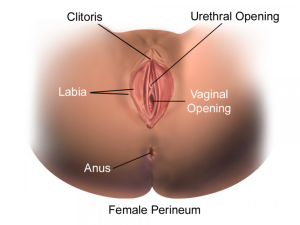15.11 Inspection of the External Female Genitalia
Inspecting the external female genitalia involves the following steps:
1. Before inspecting the genitalia, assess for the presence of anxiety.
- Examination of the female genitalia is often referred to as a gynecological exam and can create feelings of discomfort and nervousness in clients, so you should always employ a trauma-informed approach.
- Explain each step, including the lithotomy positioning.
- Ask permission to touch.
- Use a drape, and only expose the client as long as needed.
- Avoid words that may be triggering, such as “bed” and “spread your legs.” Instead, use “exam table” and make requests like “move this leg out.”
- Ask the client if they would like to have another person present such as a family member/friend or another health care provider.
2. The female genitalia (see Figure 15.10) are collectively called the “vulva,” and include mons pubis, labia minora, labia majora, vulvar vestibule, prepuce, clitoris, urethra meatus, vaginal opening and perineum.
- Inspect the vulva for hair distribution, symmetry, color, swelling, bruising, erythema, rashes, lesions, masses, or discharge.

Palpating the external female genitalia ** This is an advanced skill
- Palpation of the internal reproductive organs includes ovaries and uterus.
- Palpation of vulva for masses and nodules.
Knowledge Bites: Forensic Nursing
The International Association of Forensic Nurses (2024) defines forensic nursing, as outlined in Forensic Nursing: Scope and Standards of Practice, as the practice of nursing globally when health and legal systems intersect. This organization further describes their role with victims of violence and abuse, who require care from a health professional trained to treat the trauma associated with the wrong that has been done to them—be it sexual assault, intimate partner violence, neglect, or other forms of intentional injury. Forensic nurses are also a critical resource for anti-violence efforts. They collect evidence and give testimony that can be used in a court of law to apprehend or prosecute perpetrators who commit violent and abusive acts.

